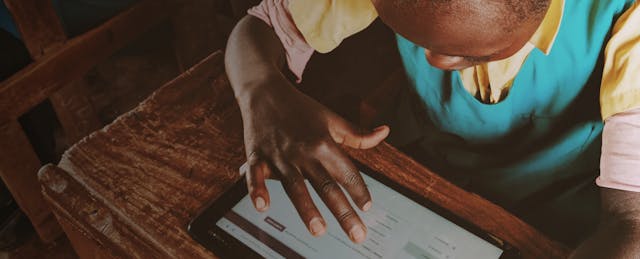Access to high-quality education is widely recognized as a pivotal tool for alleviating poverty, mitigating the spread of disease and malnutrition, fostering children's overall welfare and empowering women. Unsurprisingly, the United Nations asserts that quality education is not only a fundamental human right but also a crucial catalyst for economic growth and development.
Endless Network, a global organization dedicated to promoting equity and accessibility, invests strategically in companies worldwide to address challenges such as limited access to quality education. This article focuses on one of those organizations, Learning Equality.
Learning Equality offers educational opportunities for the 2.6 billion people worldwide without internet access. It focuses on delivering quality teaching and learning through technology without the internet. The nonprofit was founded in response to the global wildfire adoption of its first-generation learning platform, KA Lite, which provided offline access to Khan Academy videos and exercises. This made clear the sheer need and readiness for offline-first edtech tools that address challenges in connectivity and access to quality digital learning materials in low-resource contexts.
Harnessing its learnings from KA Lite, the organization has evolved and expanded its impact by developing an ecosystem of open products and tools called Kolibri. Kolibri enables offline access to a curated library of educational content, supports customized curricula creation and facilitates self-paced, differentiated and project-based learning.
Recently, EdSurge spoke to Lauren Lichtman, head of strategy and partnerships, about Learning Equality’s unique collaborative approach to enabling equity in education through technology. Lichtman applies her own experience building relationships to her passion for identifying solutions that break down barriers to quality learning.
EdSurge: What is Learning Equality’s vision in the field of education?
Lichtman: Learning Equality’s vision is to create an equitable world in which all learners develop their own agency, create positive transformation and flourish. The approach involves building adaptable and user-friendly solutions, promoting organic and scalable edtech use, prioritizing student-centered and equitable learning experiences, advocating for systems change and actively building learning communities. All of this is part of our theory of change. We take a bottom-up approach to education technology in a way that is contextual and responsible.
What do you mean by a bottom-up approach?
When I say bottom-up, I mean that we enable organizations to have ownership over how they contextualize education technology specific to their local needs and experience. Our goal is to enable sharing in a way that isn't directive. Our approach is designed to supplement and complement what is already happening in formal classrooms and support flexible edtech use across a variety of learning environments. With Kolibri, we provide a free and open-source learning platform that's really designed for learners with limited digital literacy skills, so there aren’t as many barriers to adoption. Kolibri isn’t preloaded with any specific content, but we have a library of content for organizations, curriculum designers and others to pick from and tools to organize content according to the curriculum. We provide openly-licensed documentation, guidance materials and training materials through the Kolibri Edtech Toolkit to help organizations set up Kolibri on their own and train educators and staff on how to blend technology into their learning environments. All of this supports a community-driven, bottom-up approach. This do-it-yourself adoption model is one of the things that makes Learning Equality really unique and the reach really broad — more than 10 million people across 220 countries and territories.
It’s important to note that while this model supports broad adoption at scale, Learning Equality also works in partnership with organizations working at scale or across contexts, and sometimes that includes partnering with Ministries of Education to support the delivery of Kolibri at scale in a more top-down manner. Even in this case, Kolibri gives agency to educators and organizations to use it in a way that makes sense for the particular learning environment.
How is Learning Equality addressing the challenge of the digital divide and the 2.6 billion people without internet access?
First, it's important to think about the different facets of the digital divide. The term digital divide often refers to not having affordable access to the internet or specific hardware. But another important aspect is thinking about digital literacy skills and digital rights. Learners who aren't connected to the internet don't have as many opportunities to learn with technology or to develop digital skills which are increasingly necessary for the workforce. We’ll only see this divide widen with the onset of generative AI where its use is reliant on strong internet connectivity.
We think of connectivity along a spectrum; it's not black and white. It's often the case that you might have some internet, but it's intermittent and with limited bandwidth. Because of that, we've focused on using connectivity — when it does exist — in smart ways to enhance teaching and learning. For example, Kolibri can be installed and updated with the software and content in different ways. One way is directly from the internet, but the other is from having it installed locally with a USB or hard drive or peer-to-peer with nearby devices. Then, even when installing Kolibri, organizations only import the content they need on account of bandwidth considerations. Additionally, Kolibri is designed to run on low-cost and legacy devices, so you don't need the latest and greatest hardware for it to run.

How does Learning Equality collaborate with partners to understand and support the unique needs of different contexts, and how is this reflected in the design of its educational tools?
Getting feedback from our community and partners is a core product development aspect. Everything we do in our roadmap is informed by and/or developed in collaboration with our community. We have four core design principles that drive our development of products: equitable access, effective learning, community ownership and consistent experiences. While we support the do-it-yourself model that I already mentioned, we partner directly with organizations to test and iterate on Kolibri so that we can build a better product.
For example, our next version of Kolibri features the ability for learners to practice taking old exams as a tool for self-assessment. This new feature grew out of feedback from Vodafone Foundation and UNHCR’s Instant Network Schools programme, which has been using Kolibri since 2018 to support refugee learners. This version also allows organizations collaborating with Learning Equality to use Kolibri to survey its learners, teachers and administrators to support ongoing monitoring and evaluation during a program. This specific feature was initially driven by an assessment by the Harvard EASEL Lab of the use of Amal Alliance’s Colors of Kindness with Kolibri.
We’ve also collaborated with organizations like Shoulder to Shoulder in Honduras, which works closely with the Department of Education to support improved learning outcomes, and its curriculum-aligned CREE content is now included publicly in the Kolibri Library for anyone to use.
More recently, we worked to understand how to leverage Kolibri to support project-based learning to improve foundational skills through a new project in Uganda. We partnered with two organizations to co-develop and implement this approach with a curriculum aligned with the national standards specifically for over-age, out-of-school refugee learners for grade three equivalent. In just 12 weeks, we saw math scores increase from 44 to 87 percent, literacy scores increase from 13 to 71 percent and significant gains in social-emotional skills.
It is important to note that not all of our collaborations exist outside of the United States. For example, we worked with an intermediary unit in Pennsylvania to support learners with limited connectivity during COVID to ensure they had access to the necessary learning materials.
Another use case for Kolibri in the United States is in correctional systems. We have supported the Idaho Department of Corrections to help learners with STEM subjects and the acquisition of GEDs. Often, these learners developed the skills to become mentors or coaches within the system, supporting others to learn.
How to get involved in Learning Equality's work: There are many ways in which you, too, can help make quality educational opportunities accessible to everyone.
- Donate to support our efforts. A donation of $25 will cover the cost of bringing ten children’s books offline to support learners without internet access.
- If you’re bilingual or multilingual and interested in translating Kolibri into your language, email us at i18nteam@learningequality.org.
- We welcome open-source contributors to our GitHub Kolibri repository; you can get started here.
- Download the latest version of Kolibri.
- Already using Kolibri? Share your story with us via the Community Forum or send us an email at stories@learningequality.org.
- Follow us on X (formerly Twitter), Facebook, Instagram, YouTube, and LinkedIn, and stay in the loop with Learning Equality by subscribing to our newsletter and reading our blog.



